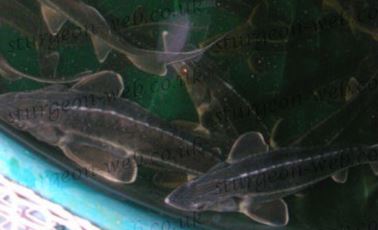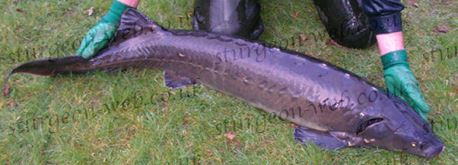Sturgeon Hybrids

Hybrid sturgeons
Hybrid sturgeons, as with many animals, are bred to get the best from both parents and hopefully leave the bad behind. A very common sturgeon hybrid is a Bester, which is a cross between a Beluga and a Sterlet. This hybrid offers the growth of the Beluga and the early age of sexual maturity from the Sterlet (the good) and it leaves behind the bad, the Beluga's cannibalistic tendencies and the slow growth and poor caviar of the Sterlet.![]()
Common hybrids:
- Beluga (Huso huso) x Sterlet (Acipenser ruthenus) - Bester
- Diamond (Acipenser gueldenstaedtii) x Adriatic (Acipenser naccarii)
- Diamond (Acipenser gueldenstaedtii) x Siberian (Acipenser baerii)
- Diamond (Acipenser gueldenstaedtii) x Sterlet (Acipenser ruthenus)
- Siberian (Acipenser baerii) x Sterlet (Acipenser ruthenus)
- Siberian (Acipenser baerii) x Adriatic (Acipenser naccarii) - Baccari

Diamond Sturgeon (Acipenser gueldenstaedtii) x Adriatic Sturgeon (Acipenser naccarii) hybrid
Natural hybrids often occur in the wild, as many species share the same spawning grounds. One common natural hybrid is a cross between the Pallid (Scaphirhynchus albus) and the Shovelnose (Scaphirhynchus platorynchus) which both spawn in the Mississippi and Missouri Rivers. In the Volga River natural hybrids include a cross between the Diamond (Acipenser gueldenstaedtii) and Sterlet (Acipenser ruthenus) and a cross between the Diamond (Acipenser gueldenstaedtii) and Stellate (Acipenser stellatus).![]()
Hybrid Fertility
All sturgeon species can be crossed with each other but not all hybrids are fertile. Sturgeon species can be divided into two groups according to the number of chromosomes.![]()
Group one is diploid, having ± 120 chromosomes:
- Acipenser nudiventris
- Acipenser oxyrinchus oxyrinchus
- Acipenser oxyrinchus desotoi
- Acipenser ruthenus
- Acipenser stellatus
- Acipenser sturio
- Huso dauricus
- Huso huso
- Polyodon spathula
- Pseudoscaphirhynchus fedtschenkoi
- Pseudoscaphirhynchus hermanni
- Pseudoscaphirhynchus kaufmanni
- Scaphirhynchus albus
- Scaphirhynchus platorynchus
- Scaphirhynchus suttkusi
Group two is tetraploid, having ± 240 chromosomes:
- Acipenser baerii
- Acipenser brevirostrum
- Acipenser dabryanus
- Acipenser fulvenscens
- Acipenser gueldenstaedtii
- Acipenser medirostris
- Acipenser mikadoi
- Acipenser naccarii
- Acipenser persicus
- Acipenser schrenckii
- Acipenser sinensis
- Acipenser transmontanus
Hybrids of species within the same group are fertile but cross breeding between the two groups produces triploid (160-180 chromosomes) hybrids which are sterile. Fertile hybrids can be cross bred again to produce even more variation, which makes the task of identifying hybrids quite difficult.![]()

Diamond Sturgeon (Acipenser gueldenstaedtii) x Siberian Sturgeon (Acipenser baerii) hybrid
Written by Terry White & Graham Quick
Contents
Home
Sturgeon Species
Sturgeon Care
Sturgeon Health
Water Quality
Our Other Sites

Copyright © 2000-2024
www.sturgeon-web.co.uk
All Rights Reserved.
Protected by UK Copyright Service Registration No:311386
